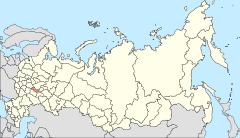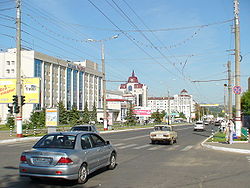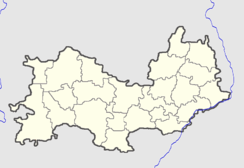- Saransk
-
Saransk (English)
Саранск (Russian)
Саранош (Moksha)
Саран ош (Erzya)- City[citation needed] -
Kommunisticheskaya Street in Saransk
Location of the Republic of Mordovia in RussiaCoordinates: 54°11′N 45°11′E / 54.183°N 45.183°ECoordinates: 54°11′N 45°11′E / 54.183°N 45.183°E Coat of arms Flag City Day June 12[citation needed] Administrative status Country Russia Federal subject Republic of Mordovia Capital of Republic of Mordovia[citation needed] Municipal status (as of October 2008) Urban okrug Saransk Urban Okrug[citation needed] Head of Administration[citation needed] Vladimir Sushkov[citation needed] Representative body Council of Deputies[citation needed] Statistics Area 71.5 km2 (27.6 sq mi)[citation needed] Population (2010 Census,
preliminary)297,425 inhabitants[1] - Rank in 2010 64th Population (2002 Census) 304,866 inhabitants[2] - Rank in 2002 62nd Density 4,160 /km2 (10,800 /sq mi)[3] Time zone MSD (UTC+04:00)[4] Founded 1641[citation needed] Postal code(s) 430000[citation needed] Dialing code(s) +7 8342[citation needed] Official website Saransk (Russian: Сара́нск; Moksha: Саранош; Erzya: Саран ош) is a city in central European Russia and the capital of the Republic of Mordovia, as well as its financial and economic center. It is located in the Volga basin at the confluence of the Saranka and Insar Rivers, about 630 kilometers (390 mi) east of Moscow. Population: 297,425 (2010 Census preliminary results);[1] 304,866 (2002 Census);[2] 312,128 (1989 Census).[5]
Contents
History
Saransk was founded in 1641 as the Russian fortress Atemar, which took its name from a nearby Mordvin village; the fortress was, at the time, located on the southeastern frontier of Russia. The current name "Saransk" refers to the city's situation on the Saranka river. Soon after its founding, the city became an important trade center for nearby Erzya villagers. After 1708, Saransk was assigned to the Azov Province, and latter to the Kazan Governorate. In 1780 the settlement was granted town status and was again transferred, this time to Penza Province. In 1928 Saransk become the administrative center of the newly established Mordvin National Area (Ogrug) which was transformed into the Mordovian Autonomous Region in 1930. Soviet planners reconstructed the old city center in the 1960s and 1970s, adding wide streets and planning the construction of massive residential areas.
Industry
Industrial activity in Saransk includes the production of electrical cables, chemical production, textile manufacturing, food processing, machine building, and metallurgy. The city has two thermal power stations.
The most notable industrial enterprises include The Lisma Electrical Factory which employs nearly 12,000 people; the Biokhimik pharmaceutical facility; Rezinotekhnika, a rubber products manufacturer; The cable manufacturer Saranskkabel; and Elektrovypryamitel, which manufactures electronic components and, on a small scale, televisions.
Demographics
Saransk is by far the largest city in Mordovia and accounts for 34.3% of the total population of the Republic (as of the 2002 Census). Ethnic Russians form the majority of the population (about 85%), and Russian, rather than any of two co-official Mordvinic languages, is the common language of communication in the city. As with many provincial capitals in Russia, the population of Saransk has decreased since the dissolution of the USSR, primarily as a result of economic migration to larger cities, made especially attractive by the downsizing, or outright collapse, of many smaller, regional, industrial enterprises.
Culture and religion
Saransk has several theaters, including the Dramatic Theater (founded in 1961), The State Puppet Theater of the Republic of Mordovia, and a Comedy theater. The Saransk Regional Museum is dedicated primarily to the history of the city, while The Mordovian Museum of Visual Arts, has an excellent collection of works by Russian masters Stepan Erzia and Fedot Sychkov.
The city is also home to Mordovian State University (founded in 1957) as well as several technical colleges.
Saransk have three Orthodox Churches and also a small Lutheran Church provided by the Finnish Lutheran Church and opened in 2005. In Saransk there are also three Mosques.
Cityscape and architecture
The town has a large number of buildings remaining from the 17th and 18th centuries, however many parts of the town are dominated by Soviet era apartment blocks, dating mainly from the 1960s, similar to other provincial towns which expanded rapidly due to fast industrialization. These buildings are nearing the end of their service life and are in need of serious repair and, in many cases, replacement. Industrial enterprises are mainly located to the north of the town center. The eastern part of Saransk, located east of the Insar River, is Posop. An interesting detail is the Soviet era military base, belonging to the Ministry of Internal Affairs, which is located along the railway lines and serves of a time when Saransk was, effectively, a closed city. Another city landmark is The Saransk TV Tower — a 180-meter-tall guyed tubular steel mast built in 1961.
Transportation
The municipal transit system of Saransk consists primarily of a network of bus and trolleybus lines.
Saransk is a station on the Kuybyshev Railway, and has additional stations serving regional rail lines to Ruzayevka and Krasnyi Uzel. Formerly, Saransk was also served by two daily Penza–Nizhny Novgorod passenger trains, carrying passengers from nearby villages mainly to either Ruzayevka junction station and Penza or to Arzamas and Nizhny Novgorod.
The city is served by the small Saransk Airport (Russian: Аэропорт Саранск) (IATA: SKX, ICAO: UWPS) located to the southeast of downtown. It is served primarily by small regional carriers; the most common aircraft is the An-24. There are regular daily flights to and from Moscow's Domodevdo airport on weekdays. Saransk is also home to the Lyambir air-force base.
Twin towns/sister cities
Saransk is twinned with:[6]
References
- ^ a b Федеральная служба государственной статистики (Federal State Statistics Service) (2011). "Предварительные итоги Всероссийской переписи населения 2010 года (Preliminary results of the 2010 All-Russian Population Census)" (in Russian). Всероссийская перепись населения 2010 года (All-Russia Population Census of 2010). Federal State Statistics Service. http://www.perepis-2010.ru/results_of_the_census/results-inform.php. Retrieved 2011-04-25.
- ^ a b Федеральная служба государственной статистики (Federal State Statistics Service) (2004-05-21). "Численность населения России, субъектов Российской Федерации в составе федеральных округов, районов, городских поселений, сельских населённых пунктов – районных центров и сельских населённых пунктов с населением 3 тысячи и более человек (Population of Russia, its federal districts, federal subjects, districts, urban localities, rural localities—administrative centers, and rural localities with population of over 3,000)" (in Russian). Всероссийская перепись населения 2002 года (All-Russia Population Census of 2002). Federal State Statistics Service. http://www.perepis2002.ru/ct/doc/1_TOM_01_04.xls. Retrieved 2010-03-23.
- ^ The value of density was calculated automatically by dividing the 2010 Census population by the area specified in the infobox. Please note that this value may not be accurate as the area specified in the infobox does not necessarily correspond to the area of the entity proper or is reported for the same year as the population.
- ^ Правительство Российской Федерации. Постановление №725 от 31 августа 2011 г. «О составе территорий, образующих каждую часовую зону, и порядке исчисления времени в часовых зонах, а также о признании утратившими силу отдельных Постановлений Правительства Российской Федерации». Вступил в силу по истечении 7 дней после дня официального опубликования. Опубликован: "Российская Газета", №197, 6 сентября 2011 г. (Government of the Russian Federation. Resolution #725 of August 31, 2011 On the Composition of the Territories Included into Each Time Zone and on the Procedures of Timekeeping in the Time Zones, as Well as on Abrogation of Several Resolutions of the Government of the Russian Federation. Effective as of after 7 days following the day of the official publication).
- ^ "Всесоюзная перепись населения 1989 г. Численность наличного населения союзных и автономных республик, автономных областей и округов, краёв, областей, районов, городских поселений и сёл-райцентров. (All Union Population Census of 1989. Present population of union and autonomous republics, autonomous oblasts and okrugs, krais, oblasts, districts, urban settlements, and villages serving as district administrative centers.)" (in Russian). Всесоюзная перепись населения 1989 года (All-Union Population Census of 1989). Demoscope Weekly (website of the Institute of Demographics of the State University—Higher School of Economics. 1989. http://demoscope.ru/weekly/ssp/rus89_reg.php. Retrieved 2010-03-23.
- ^ http://adm-saransk.ru/saransk/
External links
- (Russian) Official website of Saransk
- (Russian) Afisha of Saransk
- (English) Saransk city streets views
Administrative divisions of the Republic of Mordovia 
Cities and towns 
Administrative districts Ardatovsky · Atyashevsky · Atyuryevsky · Bolshebereznikovsky · Bolsheignatovsky · Chamzinsky · Dubyonsky · Ichalkovsky · Insarsky · Kadoshkinsky · Kochkurovsky · Kovylkinsky · Krasnoslobodsky · Lyambirsky · Romodanovsky · Ruzayevsky · Staroshaygovsky · Temnikovsky · Tengushevsky · Torbeyevsky · Yelnikovsky · Zubovo-PolyanskyCapitals of the Republics of Russia Categories:- Capitals of republics of Russia
- Saransk
Wikimedia Foundation. 2010.



